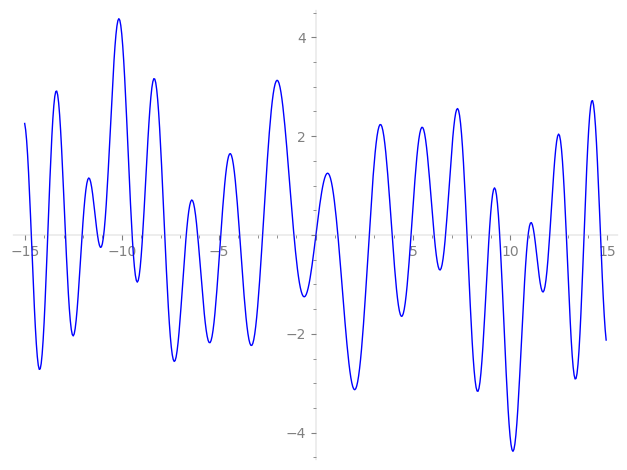| L(s) = 1 | − 10.3·3-s − 25·5-s − 38.6·7-s − 135.·9-s + 439.·11-s + 169·13-s + 259.·15-s − 1.80e3·17-s + 1.33e3·19-s + 400.·21-s + 1.49e3·23-s + 625·25-s + 3.92e3·27-s + 245.·29-s − 3.08e3·31-s − 4.56e3·33-s + 965.·35-s + 1.49e4·37-s − 1.75e3·39-s + 4.90e3·41-s + 1.60e4·43-s + 3.37e3·45-s − 2.00e4·47-s − 1.53e4·49-s + 1.87e4·51-s + 2.09e4·53-s − 1.09e4·55-s + ⋯ |
| L(s) = 1 | − 0.666·3-s − 0.447·5-s − 0.297·7-s − 0.556·9-s + 1.09·11-s + 0.277·13-s + 0.297·15-s − 1.51·17-s + 0.846·19-s + 0.198·21-s + 0.588·23-s + 0.200·25-s + 1.03·27-s + 0.0542·29-s − 0.575·31-s − 0.729·33-s + 0.133·35-s + 1.79·37-s − 0.184·39-s + 0.456·41-s + 1.32·43-s + 0.248·45-s − 1.32·47-s − 0.911·49-s + 1.00·51-s + 1.02·53-s − 0.489·55-s + ⋯ |
\[\begin{aligned}\Lambda(s)=\mathstrut & 520 ^{s/2} \, \Gamma_{\C}(s) \, L(s)\cr =\mathstrut & -\, \Lambda(6-s) \end{aligned}\]
\[\begin{aligned}\Lambda(s)=\mathstrut & 520 ^{s/2} \, \Gamma_{\C}(s+5/2) \, L(s)\cr =\mathstrut & -\, \Lambda(1-s) \end{aligned}\]
Particular Values
| \(L(3)\) |
\(=\) |
\(0\) |
| \(L(\frac12)\) |
\(=\) |
\(0\) |
| \(L(\frac{7}{2})\) |
|
not available |
| \(L(1)\) |
|
not available |
\(L(s) = \displaystyle \prod_{p} F_p(p^{-s})^{-1} \)
| $p$ | $F_p(T)$ |
|---|
| bad | 2 | \( 1 \) |
| 5 | \( 1 + 25T \) |
| 13 | \( 1 - 169T \) |
| good | 3 | \( 1 + 10.3T + 243T^{2} \) |
| 7 | \( 1 + 38.6T + 1.68e4T^{2} \) |
| 11 | \( 1 - 439.T + 1.61e5T^{2} \) |
| 17 | \( 1 + 1.80e3T + 1.41e6T^{2} \) |
| 19 | \( 1 - 1.33e3T + 2.47e6T^{2} \) |
| 23 | \( 1 - 1.49e3T + 6.43e6T^{2} \) |
| 29 | \( 1 - 245.T + 2.05e7T^{2} \) |
| 31 | \( 1 + 3.08e3T + 2.86e7T^{2} \) |
| 37 | \( 1 - 1.49e4T + 6.93e7T^{2} \) |
| 41 | \( 1 - 4.90e3T + 1.15e8T^{2} \) |
| 43 | \( 1 - 1.60e4T + 1.47e8T^{2} \) |
| 47 | \( 1 + 2.00e4T + 2.29e8T^{2} \) |
| 53 | \( 1 - 2.09e4T + 4.18e8T^{2} \) |
| 59 | \( 1 + 3.63e4T + 7.14e8T^{2} \) |
| 61 | \( 1 + 3.20e4T + 8.44e8T^{2} \) |
| 67 | \( 1 + 1.50e4T + 1.35e9T^{2} \) |
| 71 | \( 1 + 4.96e3T + 1.80e9T^{2} \) |
| 73 | \( 1 - 7.35e4T + 2.07e9T^{2} \) |
| 79 | \( 1 - 2.09e4T + 3.07e9T^{2} \) |
| 83 | \( 1 - 735.T + 3.93e9T^{2} \) |
| 89 | \( 1 - 5.97e4T + 5.58e9T^{2} \) |
| 97 | \( 1 + 1.43e5T + 8.58e9T^{2} \) |
| show more | |
| show less | |
\(L(s) = \displaystyle\prod_p \ \prod_{j=1}^{2} (1 - \alpha_{j,p}\, p^{-s})^{-1}\)
Imaginary part of the first few zeros on the critical line
−9.465724581864129417536356386625, −8.924522454764480600895555504960, −7.78522278413986188513062999139, −6.67795169173979127945194879142, −6.09106677768265013841235524208, −4.90034833810533016167584191329, −3.92716075503740590549367304071, −2.74500501128098046719002646602, −1.13163891695996596919303554860, 0,
1.13163891695996596919303554860, 2.74500501128098046719002646602, 3.92716075503740590549367304071, 4.90034833810533016167584191329, 6.09106677768265013841235524208, 6.67795169173979127945194879142, 7.78522278413986188513062999139, 8.924522454764480600895555504960, 9.465724581864129417536356386625

